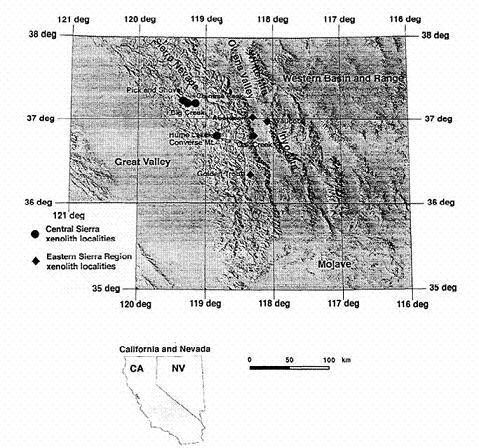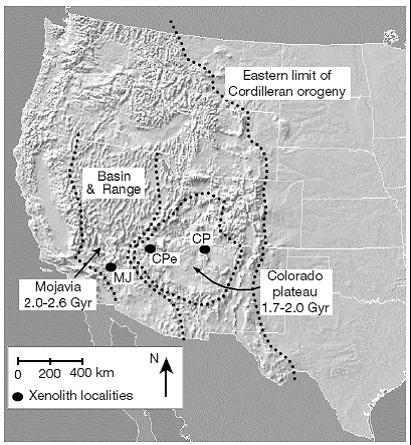Isotope Geochemistry Stuides
Ducea and Saleeby 1996/1998

from Ducea and Saleeby 1996/1998
In Ducea and Saleeby 1996, the authors examined Cenozoic volcanics for a study of geobarometry. In Ducea and Saleeby 1998, selected samples with xenoliths from the previous 1996 study were used for
radiometric isotopic study. The Nd-Sm and Rb-Sr systems were used in the analysis. Since depths were already known from the geobarometry (~35-100km) isotopic concentrations can be correlated with the
composition of material at depth. The authors found that their study sites show persisting mantle lithosphere throughout Laramide orogeny, with episilon Nd values around -3, and equivalent Sr values. (Ducea
and Saleeby 1996 and 1998)
Lee et al., 2001

from Lee et al., 2001
In Lee et al 2001, the authors examined peridotite xenoliths (samples of the lithospheric mantle) to date the partial melting and subsequent magmatism of the samples. They used the Rhenium-Osmium isotopic
system in their analysis because it is more robust against contamination in peridotites compared to other systems such as Nd-Sm. Three sites were examined; one was in Mojavia (MJ), while another was in the
Colorado Plateau (CP). A third site was on the edge of the Colorado Plateau (CPe). An important result of this study is that data from the Mojavia site shows evidence of persisting mantle lithosphere
throughout Laramide orogeny. (Lee et al 2001)
Miller et al., 2000

from Miller et al., 2000
In this study the authors examined the whole rock geochemistry of tertiary volcanism throughout the Mojave Desert and Eastern California. They looked at the isotopic compositions in the Nd-Sm and Rb-Sr
systems to determine the sources of the volcanism. The results are best viewed in the following figure. To the east of longitude 116 the samples show low episilon Nd and high Sri values consistent with
rocks sourced from the mantle lithosphere. To the west of longitude 116 the samples show high episilon Nd values and low Sri values consistent with being sourced directly from the mantle. Smaples that
reside near longitude 116 show intermediate values for each system which are consisistent with a gradational zone between the two end members. (Miller et al 2000)
Livaccari and Perry, 1993, Glazner et al. 1991
from Livaccari and Perry, 1993
In Livaccari and Perry, 1993, the authors present Nd-Sm isotopic data from several sites around the western U.S. The areal extent of their data allowed them to make the following figure, illustrating which
regions of volcanism are attributed to an asthenospheric mantle source and which are due to a lithospheric mantle source. Several study sites are notable; the sites CS, C, and MD show episilon Nd values
consistent with an asthenospheric mantle source. Livaccari and Perry also discuss the interpretation of their data, but this will be discussed here in the conclusions section. (Livaccari and Perry, 1993)
Glazner et al., 1991 also did isotpic composition work in the save vicinity as Livaccari and Perry's sites CS, C, and MD. They also found compositions consistent with rocks sourced from the mantle. (Glazner
et al., 1991)
Farmer et al., 1989
from Farmer et al., 1989
This study examined late Cenozoic basalts in southern Nevada. Among other things, the authors carried out Nd-Sm and Rb-Sr isotopic analysis of the basalts, and found a gradation in the isotopic
compositions. This can be interpreted as indicating the preservation of mantle lithosphere along the southern California-Nevada border, and is shown in the figure below. It is also important to note that
the basalts in the northern end of the study area have an Ocean Island Basalt - Asthenosphere character, based on other geochemical markers as well as the isotopic compositions. (Farmer et al. 1989)